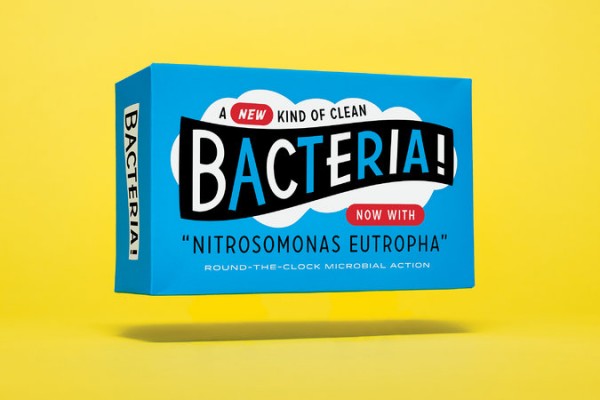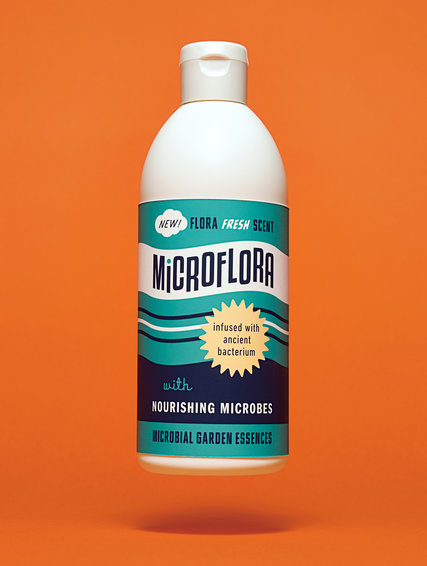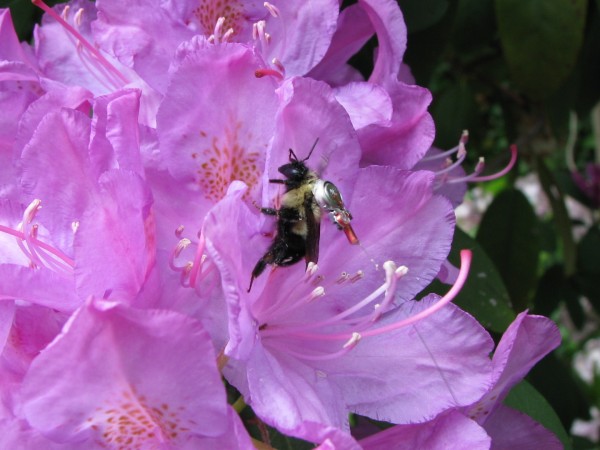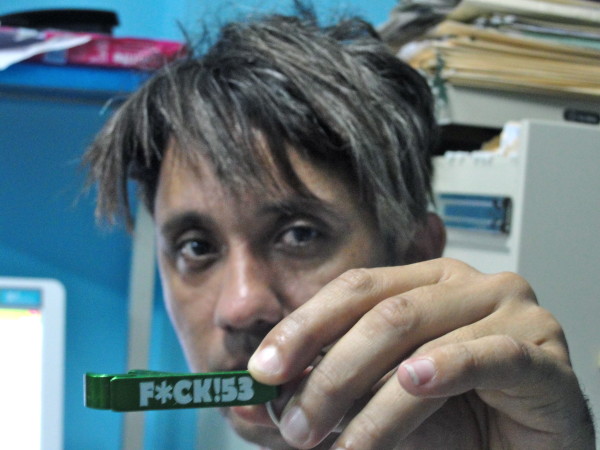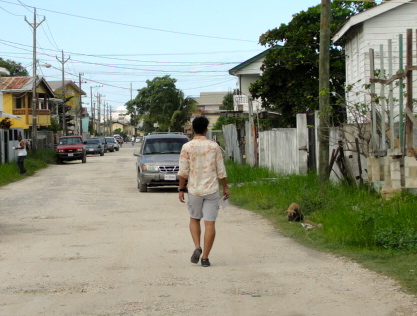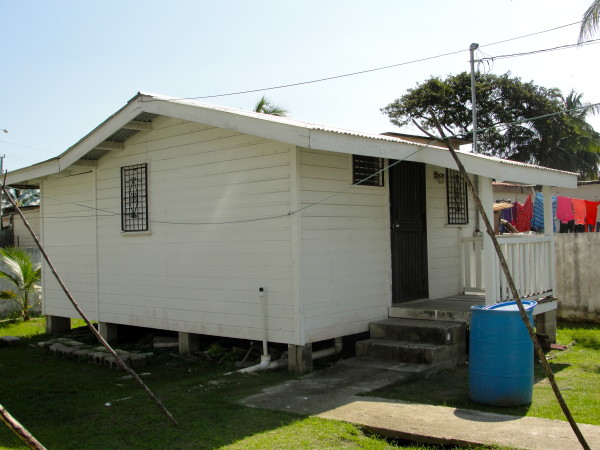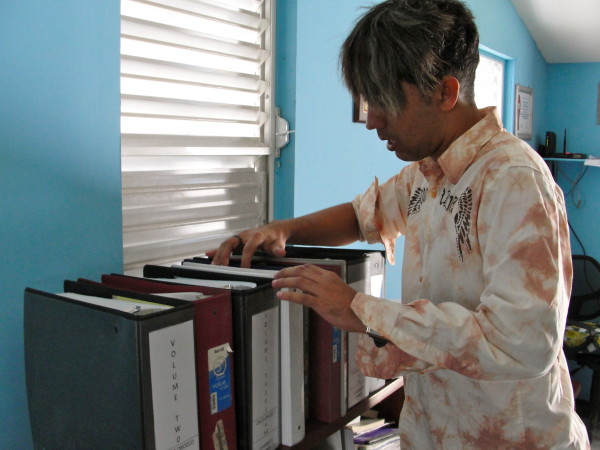
Archive for May, 2025
BON VOYAGE
Saturday, May 31st, 2025
The BBC Public Radio Partnership and producer Julia Scott present BON VOYAGE, the story of a same-sex couple from California who try to meet death in style.
Paul Perkovic and his husband, Eric Trefelner, have lived in style for 36 years. When they find out that Paul has inoperable pancreatic cancer, they decide he should go out in style, too. Eric plans a lavish, quarter million-dollar “Bon Voyage” party at a fine arts museum in San Francisco. Paul and Eric aren’t just planning a party; they’re trying to choreograph a death. But the couple soon discovers that death has its own agenda. BON VOYAGE brings the listener along on the intimate, emotional journey of a same-sex couple coping with mortality.
—
Praise for BON VOYAGE:
BON VOYAGE wins 2013 Excellence in Journalism award from the National Lesbian & Gay Journalists Association!
BON VOYAGE was nominated for Sony Radio Academy Award, Britain’s biggest radio honor.
RAVE REVIEW: The Guardian calls BON VOYAGE “Vivid and beautifully told… A tremendous listen: you felt as if you knew both subjects within moments, and got an insight into the hardest moments a relationship will face.”
—
BON VOYAGE is part of Real America, a new series from the BBC World Service that enlisted four American producers to tell stories found only in America. BON VOYAGE’s executive producer is Anne Donohue.
DURATION: 23 minutes.
Tags: BBC World Service, Bon Voyage, Eric Trefelner, Julia Scott, Paul Perkovic, PRX, Real America
Posted in Podcast and Radio Work | No Comments »
A Wash On the Wild Side: How I Learned To Stop Worrying and Love My Microbiome
Sunday, May 25th, 2025
For most of my life, if Iâve thought at all about the bacteria living on my skin, it has been while trying to scrub them away. But recently I spent four weeks rubbing them in. I was Subject 26 in testing a living bacterial skin tonic, developed by AOBiome, a biotech start-up in Cambridge, Mass. The tonic looks, feels and tastes like water, but each spray bottle of AO+ Refreshing Cosmetic Mist contains billions of cultivated Nitrosomonas eutropha, an ammonia-oxidizing bacteria (AOB) that is most commonly found in dirt and untreated water. AOBiome scientists hypothesize that it once lived happily on us too â before we started washing it away with soap and shampoo â acting as a built-in cleanser, deodorant, anti-inflammatory and immune booster by feeding on the ammonia in our sweat and converting it into nitrite and nitric oxide.
In the conference room of the cramped offices that the four-person AOBiome team rents at a start-up incubator, Spiros Jamas, the chief executive, handed me a chilled bottle of the solution from the refrigerator. âThese are AOB,â he said. âTheyâre very innocuous.â Because the N. eutropha are alive, he said, they would need to be kept cold to remain stable. I would be required to mist my face, scalp and body with bacteria twice a day. I would be swabbed every week at a lab, and the samples would be analyzed to detect changes in my invisible microbial community.
In the last few years, the microbiome (sometimes referred to as âthe second genomeâ) has become a focus for the health conscious and for scientists alike. Studies like the Human Microbiome Project, a national enterprise to sequence bacterial DNA taken from 242 healthy Americans, have tagged 19 of our phyla (groupings of bacteria), each with thousands of distinct species. As Michael Pollan wrote in this magazine last year: âAs a civilization, weâve just spent the better part of a century doing our unwitting best to wreck the human-associated microbiota. . . . Whether any cures emerge from the exploration of the second genome, the implications of what has already been learned â for our sense of self, for our definition of health and for our attitude toward bacteria in general â are difficult to overstate.â
While most microbiome studies have focused on the health implications of whatâs found deep in the gut, companies like AOBiome are interested in how we can manipulate the hidden universe of organisms (bacteria, viruses and fungi) teeming throughout our glands, hair follicles and epidermis. They see long-term medical possibilities in the idea of adding skin bacteria instead of vanquishing them with antibacterials â the potential to change how we diagnose and treat serious skin ailments. But drug treatments require the approval of the Food and Drug Administration, an onerous and expensive process that can take upward of a decade. Instead, AOBiomeâs founders introduced AO+ under the loosely regulated âcosmeticsâ umbrella as a way to release their skin tonic quickly. With luck, the sales revenue will help to finance their research into drug applications. âThe cosmetic route is the quickest,â Jamas said. âThe other route is the hardest, the most expensive and the most rewarding.â
AOBiome does not market its product as an alternative to conventional cleansers, but it notes that some regular users may find themselves less reliant on soaps, moisturizers and deodorants after as little as a month. Jamas, a quiet, serial entrepreneur with a doctorate in biotechnology, incorporated N. eutropha into his hygiene routine years ago; today he uses soap just twice a week. The chairman of the companyâs board of directors, Jamie Heywood, lathers up once or twice a month and shampoos just three times a year. The most extreme case is David Whitlock, the M.I.T.-trained chemical engineer who invented AO+. He has not showered for the past 12 years. He occasionally takes a sponge bath to wash away grime but trusts his skinâs bacterial colony to do the rest. I met these men. I got close enough to shake their hands, engage in casual conversation and note that they in no way conveyed a sense of being âuncleanâ in either the visual or olfactory sense.
For my part in the AO+ study, I wanted to see what the bacteria could do quickly, and I wanted to cut down on variables, so I decided to sacrifice my own soaps, shampoo and deodorant while participating. I was determined to grow a garden of my own.
Week One
The story of AOBiome begins in 2001, in a patch of dirt on the floor of a Boston-area horse stable, where Whitlock was collecting soil samples. A few months before, an equestrienne he was dating asked him to answer a question she had long been curious about: Why did her horse like to roll in the dirt? Whitlock didnât know, but he saw an opportunity to impress.
Whitlock thought about how much horses sweat in the summer. He wondered whether the animals managed their sweat by engaging in dirt bathing. Could there be a kind of âgoodâ bacteria in the dirt that fed off perspiration? He knew there was a class of bacteria that derive their energy from ammonia rather than from carbon and grew convinced that horses (and possibly other mammals that engage in dirt bathing) would be covered in them. âThe only way that horses could evolve this behavior was if they had substantial evolutionary benefits from it,â he told me.
Whitlock gathered his samples and brought them back to his makeshift home laboratory, where he skimmed off the dirt and grew the bacteria in an ammonia solution (to simulate sweat). The strain that emerged as the hardiest was indeed an ammonia oxidizer: N. eutropha. Here was one way to test his âclean dirtâ theory: Whitlock put the bacteria in water and dumped them onto his head and body.
Some skin bacteria species double every 20 minutes; ammonia-oxidizing bacteria are much slower, doubling only every 10 hours. They are delicate creatures, so Whitlock decided to avoid showering to simulate a pre-soap living condition. âI wasnât sure what would happen,â he said, âbut I knew it would be good.â
The bacteria thrived on Whitlock. AO+ was created using bacterial cultures from his skin.
And now the bacteria were on my skin.
I had warned my friends and co-workers about my experiment, and while there were plenty of jokes â someone left a stick of deodorant on my desk; people started referring to me as âTeen Spiritâ â when I pressed them to sniff me after a few soap-free days, no one could detect a difference. Aside from my increasingly greasy hair, the real changes were invisible. By the end of the week, Jamas was happy to see test results that showed the N. eutropha had begun to settle in, finding a friendly niche within my biome.
Week Two
AOBiome is not the first company to try to leverage emerging discoveries about the skin microbiome into topical products. The skin-care aisle at my drugstore had a moisturizer with a âprobiotic complex,â which contains an extract of Lactobacillus, species unknown. Online, companies offer face masks, creams and cleansers, capitalizing on the booming market in probiotic yogurts and nutritional supplements. There is even a âfrozen yogurtâ body cleanser whose second ingredient is sodium lauryl sulfate, a potent detergent, so you can remove your healthy bacteria just as fast as you can grow them.
Audrey Gueniche, a project director in LâOrĂ©alâs research and innovation division, said the recent skin microbiome craze âhas revolutionized the way we study the skin and the results we look for.â LâOrĂ©al has patented several bacterial treatments for dry and sensitive skin, including Bifidobacterium longum extract, which it uses in a LancĂŽme product. Clinique sells a foundation with Lactobacillus ferment, and its parent company, EstĂ©e Lauder, holds a patent for skin application of Lactobacillus plantarum. But itâs unclear whether the probiotics in any of these products would actually have any effect on skin: Although a few studies have shown that Lactobacillus may reduce symptoms of eczema when taken orally, it does not live on the skin with any abundance, making it âa curious place to start for a skin probiotic,â said Michael Fischbach, a microbiologist at the University of California, San Francisco. Extracts are not alive, so they wonât be colonizing anything.
To differentiate their product from others on the market, the makers of AO+ use the term âprobioticsâ sparingly, preferring instead to refer to âmicrobiomics.â No matter what their marketing approach, at this stage the company is still in the process of defining itself. It doesnât help that the F.D.A. has no regulatory definition for âprobioticâ and has never approved such a product for therapeutic use. âThe skin microbiome is the wild frontier,â Fischbach told me. âWe know very little about what goes wrong when things go wrong and whether fixing the bacterial community is going to fix any real problems.â
I didnât really grasp how much was yet unknown until I received my skin swab results from Week 2. My overall bacterial landscape was consistent with the majority of Americansâ: Most of my bacteria fell into the genera Propionibacterium, Corynebacterium and Staphylococcus, which are among the most common groups. (S. epidermidis is one of several Staphylococcus species that reside on the skin without harming it.) But my test results also showed hundreds of unknown bacterial strains that simply havenât been classified yet.
Meanwhile, I began to regret my decision to use AO+ as a replacement for soap and shampoo. People began asking if Iâd âdone something newâ with my hair, which turned a full shade darker for being coated in oil that my scalp wouldnât stop producing. I slept with a towel over my pillow and found myself avoiding parties and public events. Mortified by my body odor, I kept my arms pinned to my sides, unless someone volunteered to smell my armpit. One friend detected the smell of onions. Another caught a whiff of âpleasant pot.â
When I visited the gym, I followed AOBiomeâs instructions, misting myself before leaving the house and again when I came home. The results: After letting the spray dry on my skin, I smelled better. Not odorless, but not as bad as I would have ordinarily. And, oddly, my feet didnât smell at all.
Week Three
My skin began to change for the better. It actually became softer and smoother, rather than dry and flaky, as though a saunaâs worth of humidity had penetrated my winter-hardened shell. And my complexion, prone to hormone-related breakouts, was clear. For the first time ever, my pores seemed to shrink. As I took my morning âshowerâ â a three-minute rinse in a bathroom devoid of hygiene products â I remembered all the antibiotics I took as a teenager to quell my acne. How funny it would be if adding bacteria were the answer all along.
Dr. Elizabeth Grice, an assistant professor of dermatology at the University of Pennsylvania who studies the role of microbiota in wound healing and inflammatory skin disease, said she believed that discoveries about the second genome might one day not only revolutionize treatments for acne but also â as AOBiome and its biotech peers hope â help us diagnose and cure disease, heal severe lesions and more. Those with wounds that fail to respond to antibiotics could receive a probiotic cocktail adapted to fight the specific strain of infecting bacteria. Body odor could be altered to repel insects and thereby fight malaria and dengue fever. And eczema and other chronic inflammatory disorders could be ameliorated.
According to Julie Segre, a senior investigator at the National Human Genome Research Institute and a specialist on the skin microbiome, there is a strong correlation between eczema flare-ups and the colonization of Staphylococcus aureus on the skin. Segre told me that scientists donât know what triggers the bacterial bloom. But if an eczema patient could monitor their microbes in real time, they could lessen flare-ups. âJust like someone who has diabetes is checking their blood-sugar levels, a kid who had eczema would be checking their microbial-diversity levels by swabbing their skin,â Segre said.
AOBiome says its early research seems to hold promise. In-house lab results show that AOB activates enough acidified nitrite to diminish the dangerous methicillin-resistant Staphylococcus aureus (MRSA). A regime of concentrated AO+ caused a hundredfold decrease of Propionibacterium acnes, often blamed for acne breakouts. And the company says that diabetic mice with skin wounds heal more quickly after two weeks of treatment with a formulation of AOB.
Soon, AOBiome will file an Investigational New Drug Application with the F.D.A. to request permission to test more concentrated forms of AOB for the treatment of diabetic ulcers and other dermatologic conditions. âItâs very, very easy to make a quack therapy; to put together a bunch of biological links to convince someone that somethingâs true,â Heywood said. âWhat would hurt us is trying to sell anything ahead of the data.â
Week Four
As my experiment drew to a close, I found myself reluctant to return to my old routine of daily shampooing and face treatments. A month earlier, I packed all my hygiene products into a cooler and hid it away. On the last day of the experiment, I opened it up, wrinkling my nose at the chemical odor. Almost everything in the cooler was a synthesized liquid surfactant, with lab-manufactured ingredients engineered to smell good and add moisture to replace the oils they washed away. I asked AOBiome which of my products was the biggest threat to the âgoodâ bacteria on my skin. The answer was equivocal: Sodium lauryl sulfate, the first ingredient in many shampoos, may be the deadliest to N. eutropha, but nearly all common liquid cleansers remove at least some of the bacteria. Antibacterial soaps are most likely the worst culprits, but even soaps made with only vegetable oils or animal fats strip the skin of AOB.
Bar soaps donât need bacteria-killing preservatives the way liquid soaps do, but they are more concentrated and more alkaline, whereas liquid soaps are often milder and closer to the natural pH of skin. Which is better for our bacteria? âThe short answer is, we donât know,â said Dr. Larry Weiss, founder of CleanWell, a botanical-cleanser manufacturer. Weiss is helping AOBiome put together a list of âbacteria-safeâ cleansers based on lab testing. In the end, I tipped most of my products into the trash and purchased a basic soap and a fragrance-free shampoo with a short list of easily pronounceable ingredients. Then I enjoyed a very long shower, hoping my robust biofilm would hang on tight.
One week after the end of the experiment, though, a final skin swab found almost no evidence of N. eutropha anywhere on my skin. It had taken me a month to coax a new colony of bacteria onto my body. It took me three showers to extirpate it. Billions of bacteria, and they had disappeared as invisibly as they arrived. I had come to think of them as âmine,â and yet I had evicted them.
– – –
BONUS: Eavesdrop on Julia’s conversation with The 6th Floor blog at the New York Times.
Tags: AOBiome, Bacteria, Bacteria skin spray, Julia Scott, Julie Segre, Lactobacillus, Michael Fischbach, New York Times Magazine, Nitrosomonas Eutropha, No poo, Probiotic cleanser, Probiotic cosmetics, Probiotic FDA regulation, Probiotics, Skin microbiome, Sodium laurel sulfate
Posted in Front Page | No Comments »
The Last of the Iron Lungs
Thursday, May 15th, 2025
Martha Lillard is one of the last American polio victims who still rely on an iron lung respirator to breathe. Ten years ago, she was one of 30. Today, a dozen. But Martha, like other survivors, says she would rather end her life in her iron lung than risk using a modern replacement. THE LAST OF THE IRON LUNGS brings listeners inside an archaic machine â and a way of life â on the brink of extinction.
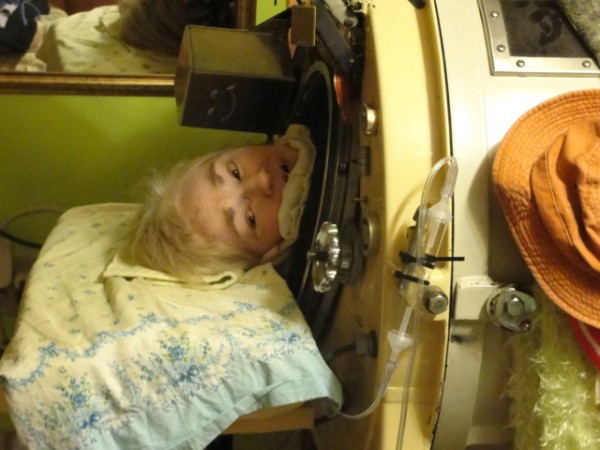 This program is part of the STEM Story Project — distributed by PRX and made possible with funds from the Alfred P. Sloan Foundation.
This program is part of the STEM Story Project — distributed by PRX and made possible with funds from the Alfred P. Sloan Foundation.
Special thanks to the March of Dimes for its archival newsreel. The March of Dimes Foundation is a United States nonprofit organization that works to improve the health of mothers and babies.
Tags: history of polio, iron lung, Julia Scott, March of Dimes, Martha Lillard, polio, polio survivor, PRX, respirators
Posted in Podcast and Radio Work | No Comments »
Tracking honeybees to save them
Thursday, May 1st, 2025
If anyone living in the village of Möggingen, Germany, had taken a close look at a bumblebee in the summer of 2009, they might have noticed something a little strange. Some of the bees were wearing what looked like small silvery backpacks with 3-inch antennae, zipping between trees and flower heads. A scientist followed discreetly behind.
The beesâ accessory was a tiny transmitter with a radar-detection range over a third of a mile. For the first time, Dr. Martin Wikelski and his colleagues at the Max Planck Institute for Ornithology succeeded in tracking bumblebees as they alighted on pear trees and nipped across meadows in idyllic and rural Germany. The study found that the bees flew up to 1.5 miles and explored areas over 100 acres, repeatedly visiting the same tree or flower patch to rest or forage. The poor bees were working hard. Given that a bumblebee weighs about 300 milligrams, packing the transmitter was the equivalent of a 150-pound person spending each day with a 100-pound barbell strapped to her back.
The backpacking bumblebees were not only a curious sight but a potential model for solving a puzzling biological mystery, colony collapse disorder (CCD), which is decimating honeybees, the bumblebeesâ smaller cousin. The seasonal epidemic eliminates at least one-third of all commercial honeybee colonies in the United States each year. This past winter, 45 percent of U.S. beekeepers, including backyard beekeepers, watched their bees abandon their hives, a 78 percent increase over the previous year, according to an annual survey funded by the U.S. Department of Agriculture.
In a recent interview, Wikelski says tracking honeybees with radio telemetry would allow scientists to identify trouble spots where the bees may come in contact with the viruses, bacteria, mites, and pesticides linked to their premature deaths. By monitoring the beesâ flights, scientists could determine a change in behavior and perhaps discover why the bees die. âThe bees would tell us what they do and what they see out there,â Wikelski says. âWe could use that information to protect them.â
Some of the bees were wearing what looked like small silvery backpacks with 3-inch antennae, zipping between trees and flower heads.
Current radio trackers arenât small or light enough to attach to honeybees, which weigh roughly a twelfth of a gram, or 120 mg, slightly more than a fat raindrop. But Wikelski, who in a previous position at Princeton pioneered the use of radio tags to track cicadas and dragonflies, says tracking technology continues to shrink. He predicts transmitters could be small enough to track honeybees in about five years.
Based in Germany, Wikelski is the founder and director of the Icarus (International Cooperation for Animal Research Using Space) Initiative. Beginning in 2015, Icarus will record animal movement, particularly that of small animals, via an antenna on the International Space Station. It will outfit 5,000 to 10,000 animals with GPS tags that relay data to the Icarus operations center.
Wikelski explains that monitoring birds, bats, insects, and rodents will provide new insights into how animals spread diseases such as malaria and avian flu. When transmitters are small enough, he says, âwe can track desert locusts and predict locust plagues.â
Icarus plans to chart how animals alter their migration routes as the planet warms and how invasive species affect ecosystems. Discovering key stopover sites for endangered species, Wikelski says, could identify new habitats for conservation. It could also lead to unexpected discoveries. Last November, Wikelski learned about a telecom blackout in war-torn Syria when he lost contact with white storks wearing tracking devices that operate in a cellphone network. He had been tracking the storks across Africa and Western Asia.
Despite years of analysis, scientists still canât pinpoint the causes of CCD. A leading candidate is the Nosema virus, a fungal spore that forms in the gut and causes diarrhea, which spreads the virus. Researchers are sharpening their focus on a ubiquitous class of agricultural pesticides called neonicotinoids. Two papers from 2012, one by a group of scientists with the USDAâs Agricultural Research Service and one from the University of Florida, demonstrated that the nicotine-derived pesticidemakes honeybees more susceptible to the Nosema virus and canalter the gene expression of honeybees exposed to Varroa mites, the leading cause of domesticated honeybee loss. Although lab results are mixed, several studies have shown that exposure to neonics, as they are called, can make bees dizzy and confused, shaky and hyperactive, and can affect their ability to forage under laboratory conditions.
Scientists have shown that the bees are contacting the offending substances outside the hive and bringing them back to infect their broods. If they knew which bees brought the viruses back, they might be able to track the pathogens to their source. That is, when the bees do come back. âWe donât know where they go,â says Eric Mussen, an apiculturist at University of California, Davis. âThey seem to go until they canât go anymore and they just drop.â
She catches bees and coats them in a glow-in-the-dark fluorescent powder, then releases them onto a hedgerow.
Honeybees arenât too difficult to follow. They tend to forage within a couple miles of the hive and to visit a particular food sourceâa field of flowers, sayâagain and again, loading up on nectar and pollen until the supply is exhausted. One-third of the food we eatâfrom beets and broccoli to apples and almondsâis pollinated by one species of commercially-raised honeybee, Apis mellifera.
In 2007 and 2008, an international team of scientists based in Australia employed tiny RFID (radio-frequency identification) tags, a transponder that emits a signal using short-distance radio waves and requires no battery life. They glued the lightweight tags onto the bees and set up a scanner at the mouth of the hive. Bees sent a signal when they left and entered the hive. The readings showed how many trips a bee made each day. In one study, scanners were set up at a hive and an artificial food source was treated with pesticides. Pesticide-dosed bees reduced their foraging habits and took more time to fly between hive and food. The RFID tags, however, were not able to follow bees in the field, as the Icarus Initiative plans to do.
Dr. Claire Kremen, a conservation biologist at University of California, Berkeley, has her own whimsical tool to follow bees in the wild. She catches bees and coats them in a glow-in-the-dark fluorescent powder, then releases them onto a hedgerow. She and her team wait until nighttime and hike out to the field with UV glasses, looking for traces of pink, blue, yellow, and greenâsprinkles of dye on the flowers the bees visited that day.
âItâs like looking for a needle in a haystack,â she says. âIf we could catch them and put little backpacks on them and find out where their nests areâoh my god, that would be enormous as far as understanding the biology of these creatures.â
Jeff Pettis, head of the U.S. Department of Agricultureâs Bee Research lab in Beltsville, Md., says tracking bees with transmitters âsounds like a very valuable tool.â He suggests the best use for bee tracking could also be the simplest. When a bee colony collapses, the bees fly away to dieâa natural instinct to avoid infecting the rest of the hive. But it makes postmortems a challenge.
âIf we were able to recover more dead bodies, we could see that the bees that died away from the hive had a higher virus load than those in the hive, or in nearby hives that appeared healthy,â Pettis says. And that would help determine where the problem started.
Still, bee tracking has its skeptics. âI think itâs going to be extremely difficult to do,â Mussen says. With more than 1,000 eggs laid in a hive every day, he asks, how could a scientist choose which bees to track? Mussen says the tests may result in a lot of disappointed researchers, who will find transmitters attached to a bee thorax left behind by a praying mantis or in the stomach of a hungry songbird.
Mussen wants to know how scientists would draw a correlation between pesticide exposure and bee behavior. Farmer A may grow a field crop with a certain pesticide, but what if the bee also alighted in Farmer Bâs neighboring field? Scientists would need to follow a beeâs every move and intervene to avoid cross-contamination. âThe only way you could isolate the pollen loads would be to continue netting the bees that are visiting Field A and keep knocking their pollen loads into a vial,â Mussen says.
The tests may result in a lot of disappointed researchers, who will find transmitters attached to a bee thorax left behind by a praying mantis.
Wikelski is only encouraged by the challenges. âYou would just tag one bee and follow it, and you learn a hell of a lot,â he says. âThen you tag the next one and you learn almost twice as much.â Trapping bees between fields, Wikelski adds, is possible. Scientists should âjust do it,â he says, and work out the details as they go. âThe kinds of questions that are important now wouldnât be important once you collect data.â
While Icarus has tracking honeybees on its drawing board, it has to wait for the development of a radio transmitter that weighs no more than 20 percent of a honeybeeâs bodyweight, an infinitesimal 24 mg, the weight of the RFID tags used by scientists in Australia.
Fabricating a transmitter that small, with its own battery source to generate radio waves, would be difficult but possible, says Michel Maharbiz, an associate professor with the Department of Electrical Engineering and Computer Science at University of California, Berkeley. âAt the moment thereâs a practical limit to how small a battery you can get,â Maharbiz says. âThere are a lot of research efforts that can make them smaller. But you canât go buy a 50-milligram lithium polymer battery off the shelf.â However, adds Maharbiz, the market for personal telemetry transmitters, like bracelet pedometers that send a signal to your cell phone, is booming, and companies are racing to develop smaller and more powerful silicon chips for new applications.
âWeâre bringing nature and technology together,â Wikelski says. âPeople have told me we canât follow songbirds. Well, weâve done it. I have no doubt that we can rescue those bees. We just have to understand them.â
Julia Scott is an award-winning journalist and radio producer whose work has been featured in Best American Science Writing. Her stories have appeared in the New York Times, Modern Farmer, and on Marketplace and the BBC World Service.
Tags: animal migration, bumblebees, Claire Kremen, Colony Collpse Disorder, Eric Mussen, honeybees, ICARUS initiative, Jeff Pettis, Julia Scott, Martin Wikelski, Nautilus, Nautilus Magazine, neoconicotinoids, neonics, radio tags
Posted in Feature | No Comments »
What Makes San Francisco Sourdough Unique?
Thursday, May 1st, 2025
If bagels are a New York thing, San Francisco definitely has sourdough. And probably no one has convinced more people that our sourdough is unique than Boudin Bakery, where tourists line up at Fishermanâs Wharf for a taste of that moist-tangy, fogbound delight.
Bay Area native (and KQED staffer) Peter Cavagnaro has been eating local sourdough all his life. Itâs his favorite bread. And that got him wondering about something. He asked KQED’s Bay CuriousâŠ.
âWhat makes San Francisco sourdough so unique?â
Here at KQED, weâve always heard thereâs something in the water or the air that makes our sourdough special. But is that really true?
It turns out that this is as much a science question as it is about the history and local mythology of our âauthenticâ local sourdough. By the time I had the answer, I also had 2 pounds of smelly homemade sourdough starter fermenting at home, and the results of a lab test that described the microbes living in it.
Taste the Microbes
To understand what makes our bread taste the way it does, you need to know how bread gets started. My investigation began in the fermentation room at Semifreddiâs bakery in Alameda, one of the best-known local producers of sourdough, along with Acme Bread Company and Tartine Bakery.
The fermentation room is the inner sanctum of the bakery. Itâs a very cold, stainless-steel vault where 300 yellow buckets brim with slow-bubbling beige goop: future sourdough. I stood there, shivering in a hairnet, with co-owner Mike Rose and head baker John Tredgold.
Rose is a soft-spoken man who talks about sourdough with wonderment, as if itâs alive â which it is, with millions of microbes.
âCan you hear it? Itâs hungry,â Rose said. âIt will be fed later today. It gets fed once a day. Equal parts flour and water.â
Before sourdough gets baked, it has to be grown. Born as a primordial glop, aptly called starter. All it needs to grow, as Rose said, is flour and water. And time. Thatâs it. If you add anything else, itâs not real sourdough. Eventually, the sugars in the flour start to break down, and fermentation happens on its own.
Tredgold handed me a plastic spoon and pointed me to a bucket. I could see bubbles rising to the surface of the bucket â a sure sign of microbial activity. The starter tasted like very sour yogurt to me, but Tredgold treated the experience like tasting a fine wine, smelling and savoring.
âThis is more like creme fraiche,â he said. âIt makes you salivate, it makes you excited to eat more.â
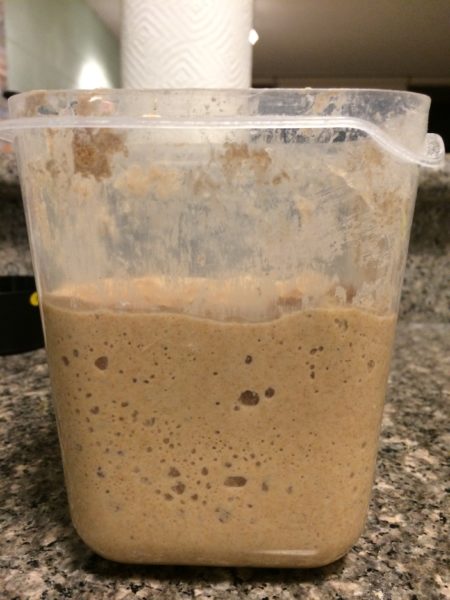
The author’s starter, looking healthy with lots of air pockets.
Flour, Water, Temperature, Time
Semifreddiâs produces 9,500 loaves of sourdough each day. But no two loaves taste exactly alike. And thatâs because the starter is alive with millions of wild yeast cells and naturally occurring bacteria. The yeast makes the bread rise. And the bacteria create the acids that make the bread sour.
The flavors vary from day to day, and batch to batch. Sourdough is one of the most ancient breads, dating back at least 5,000 years. Itâs reasonably easy to create a starter from scratch, but tricky to master the triple arts of crust, crumb and flavor when baking. So much depends on capturing enough wild yeast to make the bread light and airy. (Adding commercial yeast is not a permitted technique at the baking stage if the goal is authentic, old-fashioned sourdough).
âWe try to control it by temperature and time. And our hands. Itâs never fully totally under control, because weâre dealing with natural organisms,â said Rose. âI love it,â he added with a grin.
Rose was so passionate that I decided to try growing my own sourdough starter at home (more on that below).
The Boudin Lore
A little voice nagged at me, though. Anyone can make sourdough, but would it be authentic if it wasnât born in San Francisco? (I live in Oakland).
No one has convinced more people about the unique qualities of San Francisco sourdough than Boudin, which says itâs been selling the same loaf of bread for 168 years. According to the Boudin Bakery museum at Fishermanâs Wharf, the companyâs mother dough follows an unbroken line back to the Gold Rush in 1849. Louise Boudin even saved the starter from a burning building in the 1906 earthquake.
A museum docent told me the starter is so special and irreplaceable that the Boudin mothership sends its retail stores fresh starter every 23 days. Without it, they say the sourdough those stores produce would stop tasting like San Francisco sourdough and start tasting like San Diego or Sacramento sourdough.
Why? Well, according to the museum, Boudin bread owes its special flavor to a strain of bacteria that thrives only in San Franciscoâs climate. Scientists identified it here in 1970, so they named it Lactobacillus sanfranciscensis.
Â
Not That Unique, Actually
Itâs a great story. Too bad itâs not quite true.
Scientists did identify Lactobacillus sanfranciscensis here. But recent studies have found it in up to 90 percent of countries where sourdough is produced. So from a biological standpoint, San Francisco sourdough is not all that distinctive.
âItâs something that everyone thinks is unique to San Francisco and that is not true at all,â said Ben Wolfe, a microbiologist at Tufts University in Boston. His lab studies fermentation full time ⊠including the microbes you find in sourdough.
So, case closed? Not quite.
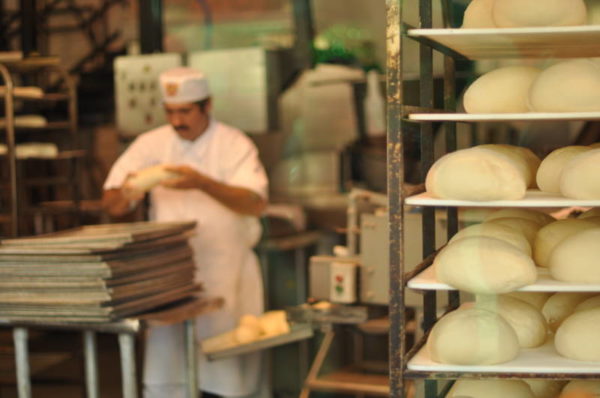
Boudin Bakery says their decades-old starter is the key to the bread’s flavor.
Science is still learning about the lactic acid bacteria (like L. sanfranciscensis) that give sourdough its main sour flavor. Other fermented foods have lactic acids, too, like miso, yogurt and kimchi.
But scientists donât know where they come from. Or how they get into your sourdough starter when you make it in your kitchen.
One explanation is that the bacteria could be in the flour to begin with. So when you go to the store and buy a bag of flour, itâs not sterile. They could also be on your skin or floating around your kitchen, but Wolfe says those are less likely to become the dominant bacteria in your starter.
âThis is one of the big questions weâre trying to answer in our story of American sourdough: Where are the lactic acid bacteria coming from?â said Wolfe.
The Sourdough Project
Thereâs never been a large-scale study in home kitchens to really identify the sources of bacteria at home.
Until now.
Wolfeâs lab has partnered with the Rob Dunn Lab at North Carolina State University on the Sourdough Project, the first comprehensive effort to test the DNA of sourdough starters across America â and understand the evolutionary biology that underlies the differences among starters.
The Sourdough Project is soliciting hundreds of sourdough starter samples from amateur and professional bread bakers across the country. (To participate in this public science project, get started by filling out this questionnaire).
Scientists will analyze samples to answer the baseline question: How variable are the microbes from region to region? And how much variability can be attributed to the grain of the bread, versus the air, the water or the humans involved?
There are so many factors. Wolfe ticks them off.
âIt could be the time that people ferment their breads. It could be the temperature. It could be a special set of recipes used in San Francisco than in other places.â
When I told him I was growing my own sourdough starter, he offered to analyze it.
So while science may yet discover something special is lurking in our sourdough, Wolfe isnât holding his breath.
Not even the bakers at Semifreddiâs, a company that has been in a position to benefit from the reputation of local sourdough, embrace the cachet.
Semifreddiâs head baker Tredgold says itâs pure marketing.
âIt sells the city. Itâs one of the things the cityâs known for. The bridge, the bay, the sourdough.â
And Rose, the co-owner of the bakery, added: âIf we take our local starter and bake with it in Los Angeles, I think it will taste very similar to what weâre making here,â he said.
Blasphemy! But possibly ⊠true.
My Kitchen Sourdough Experiment: Results
My own sourdough experiment lasted more than a month. I used King Arthur whole wheat flour and kept my mixture on the kitchen counter. As it grew, it smelled distressingly like vomit before it mellowed. At one point it almost spilled out of the Tupperware Iâd been keeping it in.
As my starter matured, it needed to be fed twice a day on a regular schedule. I raced home from work to give it more flour and water, spoke to it, and pampered it with field trips out to the balcony to give it some exposure to the Oakland atmosphere. (In spite of what I learned about the uncertainty of the science of microbes in sourdough, I still pictured my starter capturing beneficial wild yeast and bacteria from the atmosphere.)
I donât have pets or children, so I took photos of my starterâs regular maturity and forced my friends to admire them.
But the most important question was: How did it taste? I baked two little loaves and brought them into the KQED newsroom to get some brutally honest feedback from fellow reporters.
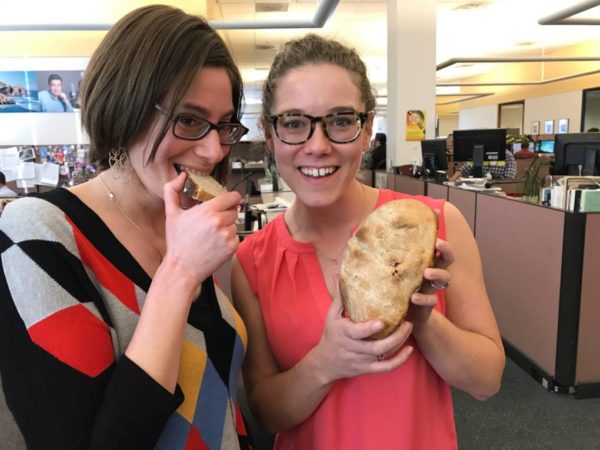
Julia Scott, left, and Bay Curious podcast host Olivia Allen-Price enjoy the fruits of Scott’s labor in the KQED newsroom — some homemade sourdough bread.
Being a first-time baker, you can imagine how this went. The loaves were so dense they had almost no air pockets. They weighed at least 3 pounds and were nearly rock-hard. My colleagues at KQED charitably praised the taste, but it was clear something had gone wrong in the baking process ⊠or with the starter itself.
A few weeks later, I got my sourdough DNA results back from Ben Wolfeâs Tufts lab. My starter had two bacterial species: Lactobacillus brevis and Lactobacillus plantarum; and one yeast species: Wickerhamomyces anomalus. All of which are very commonly found in sourdough starters made around the world, according to Wolfe. Itâs also common to have no more than a few species of yeast and bacteria in any given starter.
But that one bacterium once believed to make our bread so special â Lactobacillus sanfranciscensis? My bread didnât have any. Would things have gone differently if it had shown up? I may never know.
Tags: Bacteria, Bay Curious, Boudin Bakery, Food, Julia Scott, KQED, lactobacillus sanfranciscensis, microbiome, Semifreddiâs, sourdough
Posted in Podcast and Radio Work | No Comments »
The Loneliest Man in Belize
Thursday, May 1st, 2025
‘Rozco! Love you, hon!â cried a man in baggy jeans. His shout, insincere and taunting, was aimed at the back of Caleb Orozco, a 41-year-old man walking along a row of tarp-covered souvenir stands near one of Belize Cityâs ferry terminals. Orozcoâs only acknowledgment was to walk a little faster, car keys clutched in his hand. It was a hot December afternoon, a week before Christmas, high season in the cityâs tourist zone. Two policemen appraised Orozco but said nothing as more taunts flew. âSaw you on TV!â a woman dressed in white jeered from her craft stand, where she sold carved wooden boats. Farther down the sidewalk, two men snickered. âCaleb! You done rub too hard!â leered a man in a blue baseball cap, pointing to Orozcoâs crotch.
âBatiman!â someone called from the shade of a foodÂ-cart umbrella.
In Belize â a small Anglophone Caribbean nation tucked into the eastern flank of Guatemala and Mexico â âbatimanâ (Creole for, literally, âbutt manâ) has long been the supreme slur against gay men, the worst possible insult to their personhood and dignity. But now another slur is beginning to take its place: âOrozco.â
Five years ago, Orozcoâs lawyer walked into the Belize Supreme Court Registry and handed over a stack of papers that initiated the first challenge in Caribbean history to the criminalization of sodomy. Caleb Orozco v. the Attorney General of Belize focuses on Section 53, a statute in the Belize criminal code that calls for a 10-year prison term for âcarnal intercourse against the order of nature.â If Orozco won, his supporters hoped, it would establish a moral precedent across the Caribbean and even create a domino effect, putting pressure on other governments to decriminalize sodomy. But it took three years for the Supreme Court to hear the case; two years later, the nation still awaits a verdict.
In the meantime, Orozco operates the United Belize Advocacy Movement, or Unibam, the only gay Ârights advocacy and policy group in Belize, out of his home in a thick-walled compound on Zericote Street, where stray dogs nose for food scraps in the dirt. The walls are topped with broken shards of glass and rusty, upside-down nails. A seven-foot-tall security gate barricades his driveway. When home, he must remember to lock all six locks â two for his house, two for his office and two padlocks on the gate for good measure. Those precautions do not prevent Orozcoâs neighbor or people walking by his house from throwing rocks and bottles over the walls, shouting, âAala unu fu dedâ (âAll of you should dieâ). Other residents have picked up two-Âby-fours and chased him in the street. People stone Orozcoâs house frequently enough that he rarely bothers to call the police at this point. (This being Belize, a country with a population of just 360,000, he sometimes knows whoever is throwing the rocks on Zericote Street anyway.)
Orozcoâs natural habitat, the place where he feels powerful and at ease, is in front of his pink laptop in his office, a squat outbuilding with barred windows. Inside these walls, no one will disparage his manner of dress: snug graphic tee, stylish camo-print shorts and black Keds that hug his feet like shapely hooves. No one will comment on the way he styles his hank of hair, with a flip to the left and some highlights that tend to come out looking gray. He greets clients and funders with a soft handshake and a wry joke â usually at his own expense. When they leave, he spends hours online in the growing dark, sometimes past midnight.
âDid you know we caused the floods in Belize?â he remarked airily, scrolling through headlines on a local news site. âThereâs an actual comment from a man who says so.â Later he double-Âlocked his office doors and led the way across a yard strung with empty clothing lines, dry grass crackling underfoot. He paused for a few moments, listening for unrest from his neighborâs house, before mounting the heavily sagging steps. He jerked open the sticky door. The floor tipped at an angle, and the ceiling was patched and moldy. One window had holes big enough for him to poke his head through. âMy house is like my life â a hot mess,â he said, making his favorite joke with a wan smile.
He is Belizeâs most reviled homosexual and its most ostracized citizen, a man whom fundamentalists pray for and passers-by scorn; a marked man at 30 paces. His weary face is on the evening news and in newspaper caricatures, which have depicted him in fishnets and heels. His name is now a label, one used to remind other gays that they are sinners and public offenders. Win or lose, Orozcoâs fight for his fundamental rights and freedoms will follow him for the rest of his life.
Americans and Europeans visit Belize for all the things that make âthe Jewelâ an ideal place to relax: coral reefs, paradisiacal white beaches, a green-azure sea. It is a deeply Christian country, with a Constitution that proclaims the âsupremacy of Godâ as a first principle. Recently, it has seen a surge in Pentecostalism and other proselytizing strains of faith. Although bounded on two sides by Latin American countries with more liberal attitudes toward same-sex relationships, Belize retains a culture more closely aligned with Caribbean countries whose perspectives were colored by 200 years of British occupation. There is an ethos of âlive and let live,â but only as long as the gay community remains invisible. Gay couples cohabitate and quietly raise children, but without demanding legal recognition. Couples donât hold hands in public. No hate-crime laws exist to punish targeted assaults.
Formerly British Honduras, Belize gained independence in 1981, inheriting most of its governing documents from its former master. Section 53 is an artifact of Belizeâs colonial past dating to the 1880s. The British bequeathed similar âbuggeryâ laws to all 11 other Caribbean countries once ruled by the crown. (The Bahamas has subsequently removed them.) Buggery became a criminal offense in the England of King Henry VIII in 1533. Of the 76 countries that still criminalize sodomy around the world today, most do so as a holdover from British colonial rule. (Britain repealed its buggery laws in 2003.) In Belize, antiÂgay laws extend beyond the criminal code: Homosexuals are still technically an explicit class of prohibited immigrants, along with prostitutes, âany idiot,â the insane and âany person who is deaf and dumb.â
Much as with Lawrence v. Texas, the case whose resolution in the United States Supreme Court invalidated anti-Âsodomy laws still on the books in 13 states, Orozcoâs challenge is less about sodomy than about discrimination. Even the most zealous Christian leaders, the ones leading the crusade to keep Section 53 on the books, acknowledge that law or no law, sodomy does happen in the privacy of bedrooms in Belize â and not just between gay men, either. Despite the fact that the law is rarely enforced, Orozco and his lawyers say that the threat of indictment encourages public harassment, threats and occasional violence against many gays and lesbians, who have little recourse. The police sometimes charge hush money not to turn people in, according to Lisa Shoman, one of Orozcoâs attorneys. The Belize attorney general told me that he personally believes that Section 53 is discriminatory, though his office is obligated to defend it in court.
Orozco is an unlikely instigator of this challenge. He wasnât politically galvanized until he was 31, when he went to a workshop for gay men and people living with H.I.V. at a public health conference in Belize City. One by one, the men stood up, spoke their names and added, âI have H.I.V.â or âI have sex with men.â Orozco was bowled over. âI got up and said, âBy the way, I like men.â I realized that you perpetuate your own mistreatment by remaining silent. And I decided I would not be silent anymore.â
A year later, he helped found Unibam as a public-Âhealth advocacy group for gay men. Until that point, Orozco had never paid much attention to the H.I.V. epidemic in his country. Even after one of his uncles, who was gay, died from complications related to AIDS, Orozco didnât fully grasp what had killed him. He couldnât acknowledge being gay â to others or himself â until well into his college years. âPeople would ask me, âAre you gay?â And I would say stupid things like: âIâm trisexual. Iâll try anything just once,âââ he recalled. âThe truth was, I wouldnât try anything.â He didnât have sex until he was 23, and when he did, he felt pressured into it. He has never had a long-Âterm boyfriend. The men Orozco knows wonât be seen with him. âThere was one man who would only want me to pick him up after 8 oâclock at night,â he said, rolling his eyes. âI think about it all the time â is this the price Iâm paying? To have no love life? To be the one publicly gay man in Belize? To be the most socially isolated?â
Orozco did not have litigation on his mind at an H.I.V. conference in Jamaica in 2009 when he spoke to two law professors â one Jamaican, one Guyanese â with the University of the West Indies Rights Advocacy Project, which they had recently founded with a colleague to focus on human rights in the Caribbean. They had been studying bans on same-Âsex relationships, laying the groundwork for a test case that, if successful, could encourage similar legal challenges in neighboring countries. Belize was ideal: It had a Constitution with stronger personal privacy and equality protections than other Caribbean countries. From a human rights point of view, it was a case they thought they could win.
When Orozco heard this, he recalled, âI put up my hand â literally â and said: âWhat about me? Iâm ready since yesterday. How can we do this?âââ But even as he signed the legal papers, litigation itself was never the point. âI realized the case was simply a tool to create a national dialogue,â he said. âIt isnât just Section 53. Itâs adoption. Itâs Social Security. Itâs not having the first say of the health of your partner. Thereâs the dignity issues, which havenât been recognized.â
The legal challenge was a controversial move in Belizeâs gay community, where the question of gay rights â what they are and how to get them â is a conversation that has just barely begun. Belize has never had an inciting incident to catalyze a movement, like the 1969 Stonewall uprising. There is no annual Gay Pride parade. No member of government or other prominent figure has ever come out. No gay bars or ritual âsafe spacesâ exist as places for people to meet, just carefully organized house parties and private encounters on Facebook. The L.G.B.T. community in Belize, with the exception of a dedicated corps of organizers and supporters, remains timid, fractured and apolitical. Unibam itself has only 128 members, in part because of peopleâs concern that their names could be made public. âDonât ask, donât tell â thatâs the way with just about everything here,â said Kelvin Ramnarace, a Unibam board member. âIt doesnât mean progress. Itâs one thing to not have rights and know it. Here you think you do, because itâs not so hard to live here. But we donât.â
But Orozcoâs lawyers had reasons to hope that a softening was at hand. The tone had already begun to shift across much of neighboring Latin America, where activists were laying the groundwork for a string of victories. Today, six Latin American countries recognize same-Âsex marriage or civil unions. Eleven countries have banned employment discrimination based on sexual orientation, and seven countries protect L.G.B.T. citizens against hate crimes.
âEven though people said they anticipated some backlash in Belize, almost all the groups I spoke to seemed favorable,â said Arif Bulkan, the Guyanese lawyer Orozco met at the H.I.V. conference. Bulkan and his colleagues spoke to a range of Belizean civil-Âsociety groups and local leaders, including those in the church establishment. He recalled an important meeting with the president, at the time, of the Belize Council of Churches, which encompasses Roman Catholics, Anglicans, Methodists and Presbyterians. âHe said they wouldnât support us openly,â Bulkan said, âbut they wouldnât oppose us either.â
So Orozco had few reasons to think he might regret putting his reputation, and Unibamâs, on the line. Today, he shakes his head like a man in a dream. âI just thought it was going to be some litigation,â he said. âI didnât expect opponents, didnât expect propaganda and all that other stuff that happened.â He paused. âI really didnât.â
In Belize, church leaders are granted deference in the press and by lawmakers on social issues. But in large part, the ecclesiastical focus has always been on the spiritual rather than the political realm. So Orozco was blindsided by the announcement, soon after the suit was filed, that the Roman Catholic Church of Belize, the Belize Evangelical Association of Churches and the Anglican Church had together joined the case on the governmentâs side as an âinterested party,â a legal distinction that allowed them to hire lawyers, file motions and be heard during the trial. More than 400 church leaders and ministries came together to mobilize their adherents in the name of public morality. In another first for Belize, church leaders founded a nationwide activist campaign, Belize Action, and began drawing thousands of believers to rallies that denounced the âhomosexual agenda.â
The churches also flexed their legal muscle in a pretrial motion to remove Unibam as a claimant in the case; as an organization, they argued, it had no standing to challenge the law. Their motion succeeded. Suddenly Orozco was the sole claimant. The case would come down to whether Orozcoâs personal human rights had been violated. He was hounded for interviews, and his name was broadcast all over the world. Someone posted a video to YouTube called â[Expletive] Unibam dis da Belize,â with a photo of Orozco. He received death threats when his name was printed. Shoman, an opposition senator in the National Assembly of Belize as well as one of his lawyers, received explicit rape threats. One day, Orozco was walking downtown, alone, when a man on a bicycle, shouting antigay slurs, threw an empty beer bottle at Orozcoâs head. It smacked him on the jaw and cracked two of his molars. After taking his statement, âthe police said, âIf you find who did this, tell us, and we will pick them up.â Why is that my responsibility?â he asked me with a sardonic smile.
Before the churches joined the case, Orozco allowed three organizations to join forces as an interested party on his side: the Commonwealth Lawyers Association, the International Commission of Jurists and the Human Dignity Trust, major transnational nongovernmental organizations with global standing, large budgets and access to the best human Ârights lawyers in the world. âI thought that using interested parties from the international community would have brought some kind of leverage,â he told me.
But the presence of these foreign groups, even on paper, allowed Orozcoâs enemies to reframe the case as an act of cultural aggression by the global north. According to Bulkan, âa lot of the negative press after that was about foreigners coming in.â Prime Minister Dean Barrow told a local news station: âOne of the things that we have to be grateful for in this country is the culture wars we see in the United States have not been imported into Belize. Well, obviously, this is the start of exactly such a phenomenon.â The United States and Europe were meddling colonizers, Orozco their traitorous pawn. Orozcoâs religious opponents referred to victories for same-Âsex marriage in California and Canada as further evidence of the true agenda at work in Belize. âIt puts a lot of pressure on us,â Orozco said. âWhen we started this, we werenât thinking about gay marriage.â
Opponents made much of the fact that Unibam receives all of its budget, around $35,000 a year, from foreign governments and foundations, including the Canada Fund for Local Initiatives, the Swiss Embassy in Mexico City and the Open Society Foundations. âIs Unibam being used for a foreign gay agenda?â one news station asked. The Amandala, the nationâs largest newspaper, published a page-Âlong editorial under the headline âUNIBAM DIVIDES BELIZE.â âHomosexuals are predators of young and teenaged boys,â wrote the editor in chief, Russell Vellos, in a separate column. âWoe unto us, Belize, if homosexuals are successful in our court. Woe unto us! In fact, since ours is a âtest case,â woe unto the world!â
Six days a week, Orozco drives to his motherâs squat rental in a Belize City suburb and sits down at her glass kitchen table. Perla Ozeata, a matter-Âof-fact woman with the same dark eyes as her sonâs, serves up his favorites: steaming dark bowls of chimole, a Belizean specialty; escabeche with chicken and whole jalapeños; and her special cheesecake. Strangers have cursed her for âencouragingâ her son to be gay, but she is proud of him. The first day Orozco went to court, he wore clothes his mother bought him. She ironed his shirt and tied his tie. Sometimes when she looks at him, she still sees the friendless schoolboy who played in the yard by himself, catching lizards and trying to avoid his bullies and his fatherâs chronic disapproval. She intends to one day tear down the house on Zericote Street and rebuild, so she can move back in with him and protect him. âSomebody have to live with Caleb, because people take advantage of him,â she told me one afternoon. âCaleb no fighter. He can fight out the mouth, but he canât fight physical.â At one point, when Orozco was out of earshot, she said in a low voice: âEvery time he walk the street, they promise to kill him. Win or lose the case, theyâll kill him.â
These days Orozco leaves his compound on foot for only two reasons: to walk to the bank (10 minutes) or to the market for groceries (five minutes). On good days, he can make the 10-minute walk in seven and the five-minute one in three. But even inside a place of commerce, things can go awry. âA gentleman said he wanted to push his bat up my you-Âknow-Âwhat,â Orozco told me at one point. âI was at the bank. I had my nieces with me.â
He was sitting on his messy bed, his knees pressed together. His clothes were jammed into a dresser decorated with peeling childrenâs stickers. Twice a day, Orozco brushes his teeth over the tub because he doesnât have a sink. The walls are a single run of wooden slats with holes like gapped teeth, so pests are a problem. âCompare rats to spiders, and I prefer spiders,â he said.
Coming out is supposed to broaden your world. Orozcoâs world has narrowed to the space between these walls. Some days the tension in his neck hurts so badly that he resorts to painkillers. Other days he just feels numb. He doesnât answer his cellphone when it rings and just watches TV until he drops off to sleep. âI donât like feeling trapped,â he acknowledged. âBut I cannot afford to lose myself in this work. I create my own social space, completely.â
Once in a while he takes a chance on a night out at Dinoâs, a dance club in downtown Belize City. But he never goes without a friend. At midnight one Saturday, Orozco parked near a faded billboard with a picture of a sad-looking woman and the message âABORTION: ONE DEAD, ONE WOUNDED.â With his sister Golda, her husband and a friend, he ascended a narrow concrete stairwell to a long, dark room with earsplitting Caribbean dance music. âThis is what we do,â Orozco said, shrugging. Itâs an in-Âjoke that Belize Cityâs only gay-friendly club is on Queen Street. Drag queens have performed as dancers and singers, but on most nights, like the night we visited, the club is filled with straight couples grinding up against the plywood walls. âNot a lot of gays here,â I said. Orozco replied, âThatâs the challenge.â
There were a lot of watchful eyes at Dinoâs. Camo-clad security guards, grim-faced and armed, scanned the crowd for troublemakers. Hand-painted brontosaurs and stegosauri stared out from the walls, rendered with cartoon menace in Day-ÂGlo colors under black light. As the dancers watched one another, they took in Orozco, taller than most Belizean men at 5-foot-11, as he stood by the door for a long time in burnt-Âorange slacks and natty brogues, sipping a Coke over ice. He watched them back, seeming very ill at ease.
Orozco counted eight members of his tribe in the room that night. He knew all their names, professions and stories. But in four hours, only one, a contractor who had done some work with Unibam, approached Orozco and his group to say hello. Orozco approached no one at all. âI donât have many friends,â he acknowledged later on. âYou turn left, you have criticism. You turn right, you have indifference.â He has warm relationships with his clients and colleagues, but he doesnât socialize.
Ramnarace, the Unibam board member, told me that he supports Orozco as a leader, but that others in the gay community have their doubts. âInternationally, I think he is more accepted than he is locally,â Ramnarace said. âBecause when he says certain things here, he doesnât always come across well.â In interviews, Orozco can appear peevish or overly cerebral, seeming impatient with his interviewer or else resorting to the programmatic lexicon he uses at human rights meetings. âBut still,â Ramnarace went on, âheâs a brave little bitch to go do that, even to fumble. It isnât easy to do, not here, not alone, a little Hispanic guy.â
Orozco used to love going out dancing late at night. One memorable time at Dinoâs, he made out with a man in public, right there on the dance floor. Tonight, he and his small group formed a circle in the darkest part of the room. Golda began to dance in her gold sandals and light flowered dress, smiling at her older brother in an encouraging way. Her husband and their friend danced at her sides. Orozco, expressionless, planted himself near a pillar and began moving in place, gazing down at the floor. âAs long as I donât see an eye looking at me, I can lose myself in the music,â he said. âI just donât want to be conscious of anyoneâs eyes looking at me.â
It has now been 24 months since the hearings on Section 53, with no word on when Chief Justice Kenneth Benjamin will deliver a decision. The Supreme Court does not have a calendar for decisions, and sources close to the case have refused to speculate as to the cause of the unusual delay. The Supreme Court Registry did not answer a request for comment. âUnfortunately, civil matters in this country do proceed at a very slow pace,â Shoman said. âBut I could never have imagined that something of this magnitude, a case regarding the personal liberty of the citizens, should take so long.â She and the rest of Orozcoâs legal team have sent multiple letters to the registrar general but received no reply.
Jonathan Cooper, the chief executive of the Human Dignity Trust, is just as eager for results. âThe ramification of the Belize decision will be felt across the Commonwealth, if not beyond,â he told me. Because either side is likely to appeal any decision all the way to the Caribbean Court of Justice, the highest court for not only Belize but also Barbados, Dominica and Guyana, the controversy (and Orozcoâs notoriety) is likely to spill over into those nations as well. And then there is the matter of international human rights law. The legal groups invoked the International Covenant of Civil and Political Rights in their argument, with the knowledge that should the appeals court rule in Orozcoâs favor on that basis, other jurisdictions would find the criminalization of sodomy very hard to justify.
After waiting so many years, Orozco has made a decision of his own. Shortly after the court hearings, he quietly stepped down as the president of Unibam. He stayed on as its executive director, but he told me that he hopes to leave that post next year. âIâve come to realize that Iâve sacrificed my life to this work,â he said. âAnd I wake up to an empty bed and a pillow. And what does that say about me?â
These are not the words of a Harvey Milk revolutionary, and in fact Orozco doesnât see himself in the mold of Milk, who was murdered at 48. But Orozco has believed for some time now that he wonât outlive his middle age. âMy larger goal is to survive to the end of my case,â he said. âThey said that if something should happen to me, the case would be over. Iâve invested seven years of my life in this thing, and I donât want to throw that away.â
Orozco has come to the conclusion that the big changes he thought were within reach five years ago are actually a generation away. Living in Belize as a gay man or woman is like peering across a demilitarized zone with a pair of binoculars. If he took a four-Âhour bus ride to Chetumal, Mexico, Orozco would enjoy the right to marry. Someday, Orozco may tear down his house and rebuild it. He may go to law school or pick up the business-administration career he left behind. But he has ruled out leaving Belize. He loves his family too much. He hopes that with time, most of his fellow Belizeans will learn not to judge. âOur opponents have been fear-mongering,â he said. âMost people could care less what I do in my bedroom.â
One afternoon, Orozco took his least favorite walk, to the bank. He rose from his office chair, turned off the fan, cut the lights, locked all six locks and stepped out in a brown tie-dye button-down and kneeÂ-length cotton pinstripe shorts. The narrow downtown streets were clogged with cars short on mufflers, long on horns. He passed bakeries and pharmacies and street vendors hawking bags of peanuts and dried fruit and discount clothing stores blaring pop music.
Stoop-Âsitters on Central American Boulevard nudged one another and gestured. A man in a truck driverâs uniform, smoking a cigarette, quietly watched Orozco go by, then spat and uttered a profanity. Two adolescent girls turned to look back at his retreating form, then doubled over with laughter. Three construction workers, legs dangling in a muddy trench, looked up as Orozco walked past. âHey, Belize bwai!â they shouted. âHoo da fayri, butt bwai?â
A few steps from the bank, Orozco passed two women alongside a young girl with her hair tied back in braids, wearing gold sandals and a flouncy white dress. She gazed at Orozco with curiosity. Then she looked up. âMama,â she said, âthatâs a batiman.â
Tags: anti-gay, Belize, Belize Action, Belizean, buggery, Caleb Orozco, Caribbean Court of Justice, Caribbean gay rights, gay and lesbian, Julia Scott, LGBT, New York Times Magazine, Scott Stirm, section 53, sodomy law, Unibam
Posted in Front Page | No Comments »
© 2025 Julia Scott.

